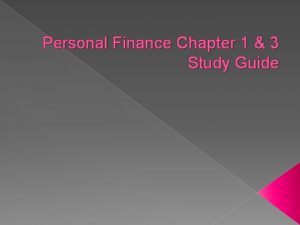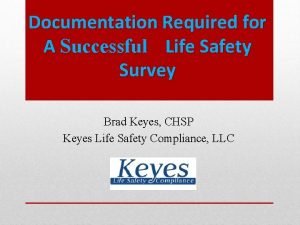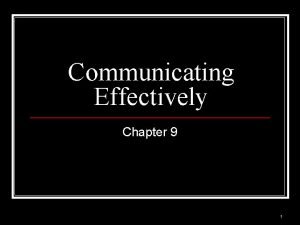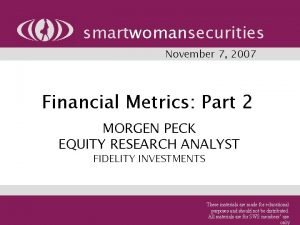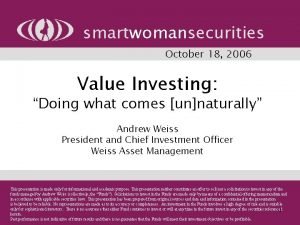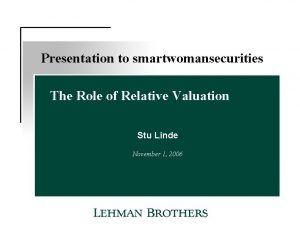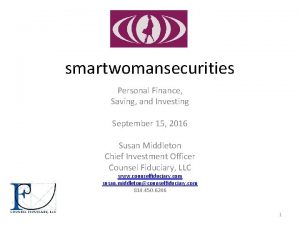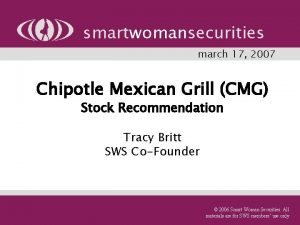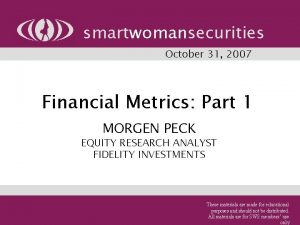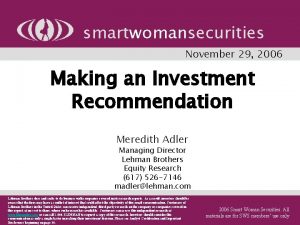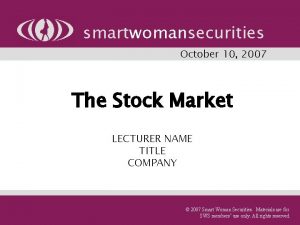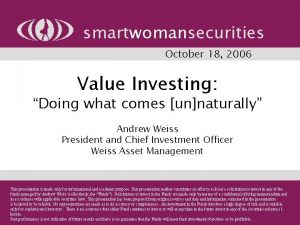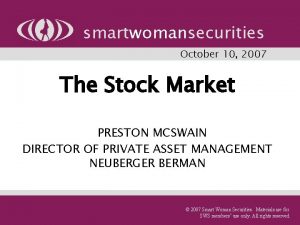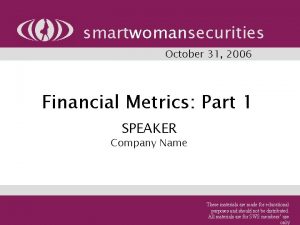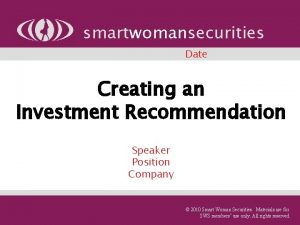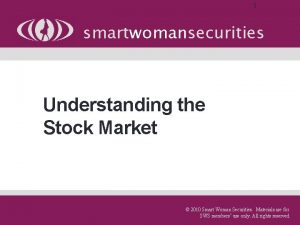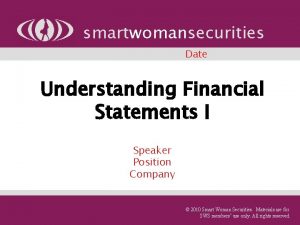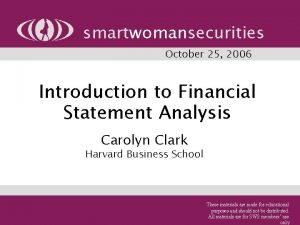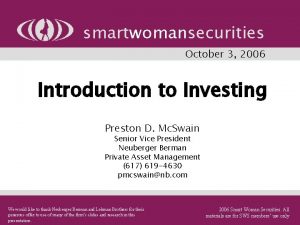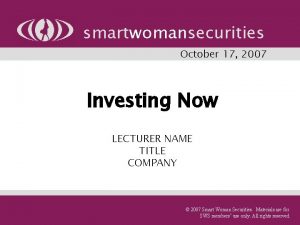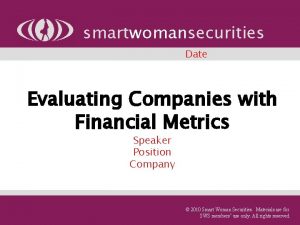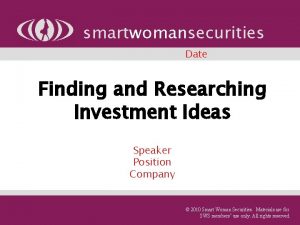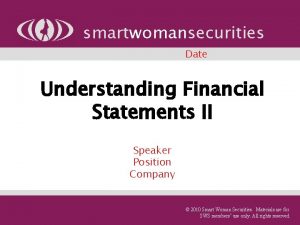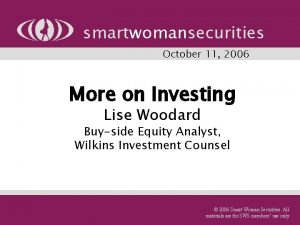smartwomansecurities April 1 2012 When Life Gives You




























- Slides: 28

smartwomansecurities April 1, 2012 When Life Gives You Lemons…Make Money! Beth Evans, Tracy Nunziati, and Hannah Koch BC SWS for BC Splash © 2011 Smart Woman Securities of Boston College

Who should invest? Why invest?

Who should invest? • Anyone can invest! – You don’t need to have a lot of money • Think about potential sources of income: – Birthday/holiday $ – Summer job – Allowance – Selling old toys on ebay • Even the smallest income adds up when you SAVE!

Why invest? • Time value of money – Start with $1, 000, earning 10% each year … but also ADD $1, 000 every year After 50 years, you’ll have only put in $50, 000… but you will have $1. 2 million+ in the bank! 4 Source: Neuberger Berman, “Investing 101” from Oct. 20, 2005

Why does it matter when I start? • Scenario 1: You don’t start investing because you need money for a car and then a house, and before you know it, you are 40. You decide to start investing $4, 000 per year for 10 years. • Scenario 2: You decide that you don’t have enough money to save right now because you need to live in that ultra chic apartment, so you decide to wait. At age 30, you start investing $4, 000 per year for 10 years. • Scenario 3: Right now, at age 15, you start investing $4, 000 per year for 10 years by using your savings from summer jobs and eventually or full-time job. You never save another dime. 5

Scenario 1: Investing at 40 • You retire with $250, 000 at age 65. 6 Note: Assumes 10% annual return and no tax effect.

Scenario 2: Investing at 30 • You retire with $700, 000 at age 65. 7 Note: Assumes 10% annual return and no tax effect.

Scenario 3: Investing NOW • You retire with almost $4 million at age 65! Note: Assumes 10% annual return and no tax effect. 8

Money Grows with Time • Power of Compounding Interest – Start with $1, 000 – Put it in an investment that earns 10% each year o 10% of $1, 000 = $100, so after the first year, you then have $1, 100 o Approximately every seven years, your money doubles o “Rule of 72”: 72 Annual percentage rate = Amount of time to double your money i. e. , 72 10 = 7. 2 years After 7 years $2, 000 After 14 years $4, 000 After 21 years $8, 000 After 28 years $16, 000 After 70 years $1, 004, 000 Source: Neuberger Berman, “Investing 101” from Oct. 20, 2005 All with an initial investment of only $1, 000! 9

Investment Options

Understand Investment Vehicles three main asset classes Stocks Bonds Cash growth alternative investments real estate hedge funds private equity income venture capital options futures liquidity stability commodities 11

Stocks (Primary Source for Growth) • A stock is a piece of ownership in a “public” company - Anyone can purchase this stock - # of Shares = how much of a company you own • As the company’s business grows, the per share value of the stock grows to reflect this - Many companies also pay back dividends to shareholders (for example, a company may pay out $1 per share each year) • Your investment return = Dividends (money the company pays out to share holders) + Returns (rising value of shares also called capital gains) 12

Bonds (Primary Source for Income) • A bond is an “I. O. U. ” • You are loaning money to someone (Federal Government, Municipal Authorities, or Corporations) • You expect the initial loan amount will be returned to you at a stated time in the future with periodic interest payments. • • This is a reason why bonds are also referred to as “fixed income” You also receive additional regular “payments” for use of your money, often called “coupons” • Types of bonds (taxable fixed income) – – Bank CDs U. S. Treasuries Corporate bonds High yield bonds • Tax-exempt – Municipal bonds = = safety and insurance safety high/medium quality lower quality/high volatility (“junk bonds”) - federal, state, local 13

Cash (Primary Source for Stability & Liquidity) • Also known as “money market” accounts – Checking/Savings Accounts with interest – Bank Money Market Funds – Mutual Fund Money Market Funds o Taxable o Tax-exempt – Short-Term Bonds (less than one year) o Treasury Bills • Low yield/return… but you know your money will be there when you need it You may have checking or savings accounts at banks like Bank of America or Chase Bank. Do you know what return you’re earning from your bank? 0. 00% Checking Account at Bank of America 0. 20% Regular Savings Account at Bank of America 1. 80% Ally Bank Savings Account (As of July 2010) 14

So, what should you invest in?

Determining your Financial Goals • Now that we know some of the main categories of investments, how can you decide what to invest in? • Step 1: Set your financial goals – In order to set your goals, you need to: o Determine a time horizon (Are you saving to buy a car, a house, or retirement? ) o Determine your investment profile (What stage in your life are you? How much money do you need to live on? How much risk can you tolerate? ) o Understand your priorities (What goals are the most important to you? ) o Quantify your priorities (How much money are you planning to save and invest and how much do you wish to have? Do these align? ) • Step 2: Determine your risk profile 16

Understanding Risk and Returns • These are two important components when judging investments – The earlier examples about the time value of money were based on earning a 10% return every year o But 10% return a year is not always possible • Not all investments have the same risk; thus, not all investments yield the same return – For example, Treasury Bonds (issued by the US Treasury) are considered low risk, and therefore offer a lower return • Higher risk often leads to higher returns – You must be compensated for taking on higher risk investments whose growth is harder to predict (more volatile) than lower risk investments • Returns are relative to the market – If your return is 10% a year, but the market return is 15% a year, then you are doing worse than the market – Other factors, such as inflation, must be considered as well. If inflation is 10% and your investment return is 10%, your “real” 17 return is 0%

Risk Tolerance Spectrum High Risk Small Company Stocks High Return International Stocks Large Company Stocks Corporate Bonds Government Bonds Low Risk Cash Equivalents ________ Source: Ibbotson Associates. Past performance is no guarantee of future results. Low Return 18

Bottom line: Make saving a priority in your financial life, then help your savings grow by investing!

Personal Finance Resources • “The more you read, the more things you will know. The more you learn, the more places you will go. ” –Dr. Seuss

Let’s Review!

Question #1 You should have at least $10, 000 in savings before you start investing. A) True B) False

Question #2 When you buy stock in Mc. Donald’s Corporation (MCD): A) You have leant money to the company B) You are eligible for a free Big Mac every time you eat at Mc. Donald’s C) Own a small part of the company. D) Mc. Donald’s will return your original investment to you plus interest after one year.

Question #3 In general, investments that are riskier tend to provide higher returns over time than investments with less risk. A) True B) False

Question #4 When you are young, it is okay to have most of your retirement savings invested in risky assets like stocks. A) True B) False

Question #5 Most successful investors like Warren Buffett. A) owe their success to luck or pure chance. B) do a lot of practical research before making any investment decision C) use impossibly complicated mathematical formulas to make investment decisions D) born with a super-human stock-picking gene

Question #6 A $100 bill that you stash under your mattress today will be worth much more when you find it there in twenty years. A) True B) False

Questions?
 Turning lemons into lemonade quotes
Turning lemons into lemonade quotes It is allah who gives life and death
It is allah who gives life and death Religion gives positive goals in life
Religion gives positive goals in life It is the spirit that gives life
It is the spirit that gives life A cash-flow statement gives you important feedback on your:
A cash-flow statement gives you important feedback on your: How does the news of the pearl affect the priest
How does the news of the pearl affect the priest Aunt minnie drops a penny
Aunt minnie drops a penny Prices you can trust slogan
Prices you can trust slogan 2012 life safety code documentation checklist
2012 life safety code documentation checklist Kicks for life
Kicks for life May you be happy in the life you have chosen
May you be happy in the life you have chosen You say you love the rain but you open your umbrella
You say you love the rain but you open your umbrella Agree or disagree questions about life
Agree or disagree questions about life If you think you can you can poem
If you think you can you can poem Tell me what you eat and i shall tell you what you are
Tell me what you eat and i shall tell you what you are I follow you wherever you go
I follow you wherever you go Your love never fails you never give up on me
Your love never fails you never give up on me Mr. antolini
Mr. antolini Kinetic theory of solids
Kinetic theory of solids Who gives a feast to introduce juliet to bachelors
Who gives a feast to introduce juliet to bachelors Carbohydrates gives
Carbohydrates gives Rima puts the tub in the sun
Rima puts the tub in the sun Primitive streak is formed from
Primitive streak is formed from Enamel organ
Enamel organ Acrophobia antonym
Acrophobia antonym A woman gives a beggar 50 cents
A woman gives a beggar 50 cents The ground gives way question answers
The ground gives way question answers Carboxylic acid to acid anhydride
Carboxylic acid to acid anhydride Welcome to the hundred acre wood
Welcome to the hundred acre wood




